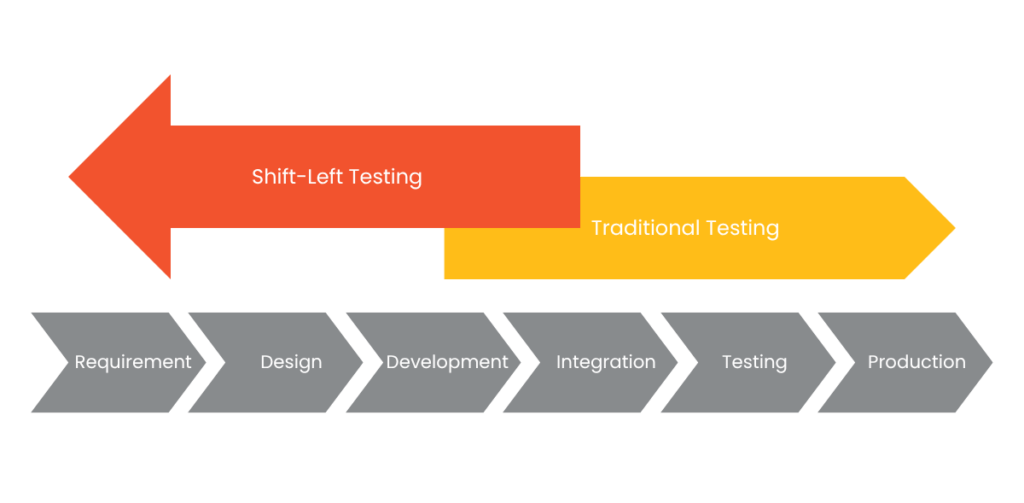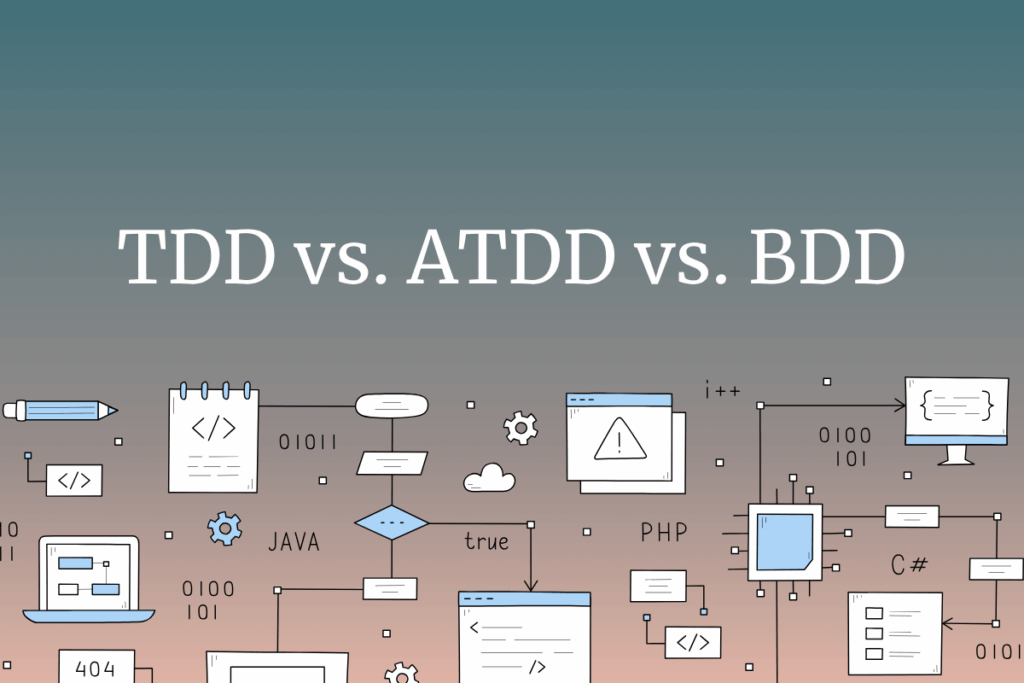In modern software development, “shifting left” isn’t just a buzzword; it’s a critical strategy for building better products faster. The shift-left movement advocates for moving testing, quality assurance, and performance evaluation to earlier stages of the development lifecycle. Three key methodologies drive this movement: Test-Driven Development (TDD), Acceptance Test-Driven Development (ATDD), and Behavior-Driven Development (BDD).
While they share a “test-first” DNA, they serve different purposes, involve different people, and focus on different aspects of the software. Let’s break them down.
What is Shift-Left Testing?
Shift-left testing refers to the practice of moving testing activities earlier in the software development lifecycle. Instead of treating testing as a final gate before deployment, shift-left approaches integrate testing into every phase of development, from initial requirements gathering through code implementation.

The core principle is simple: the earlier defects are caught, the less expensive they are to fix. A bug found during requirements analysis costs significantly less than one discovered in production.
Test-Driven Development (TDD): The Foundation
What is TDD?
Test-Driven Development is a development practice focused on implementing a component. It’s a micro-level cycle for writing clean, functional code. The primary audience for TDD is the developer. TDD follows a simple three-step cycle known as Red-Green-Refactor:
- Red: Write a small, automated unit test for a new piece of functionality. This test will fail because the code doesn’t exist yet.
- Green: Write the absolute minimum amount of code required to make the test pass.
- Refactor: Clean up the code you just wrote—improving its structure, removing duplication, and enhancing readability—without changing its external behavior. All tests must still pass.
TDD ensures that the system is built from a collection of well-tested, verifiable units. It answers the question: “Are we building the thing right?”
Example (pseudo-code): A developer writing a Calculator class would first write a test like this:
test_add_two_numbers() {
calculator = new Calculator();
assert(calculator.add(2, 3) == 5);
}
This test will fail until the add() method is implemented correctly.
Key Benefits of TDD |
Cons of TDD |
|
|
Acceptance Test-Driven Development (ATDD): Bridging Business and Technical Requirements
What is ATDD?
Acceptance Test-Driven Development (ATDD) expands the test-first approach to the feature level. It’s a collaborative practice that brings together developers, QA professionals, and business stakeholders (like product owners or business analysts) to define acceptance criteria before development begins.
The focus of ATDD is on meeting user requirements and ensuring the software behaves as the customer expects. The acceptance tests are written from the user’s perspective and describe the conditions that must be satisfied for a user story. ATDD answers the question: “Are we building the right thing?”
Example: For a login feature, the team would agree on acceptance criteria first:
- Given I am on the login page,
- When I enter a valid username and password,
- Then I should be redirected to my dashboard.
These criteria become the basis for the automated acceptance tests.
The ATDD Process
- Collaborate: Business analysts, developers, and testers work together to define acceptance criteria.
- Automate: These criteria are translated into automated acceptance tests.
- Develop: Code is written to satisfy the acceptance tests.
- Validate: Stakeholders review results to ensure business requirements are met.
Key Benefits of ATDD |
Cons of ATDD |
|
|
Behavior-Driven Development (BDD): Making Tests Human-Readable
What is BDD?
Behavior-Driven Development (BDD) is an evolution of TDD and ATDD. It aims to bridge the communication gap between technical and non-technical teams by using a shared, natural language to describe and test the system’s behavior.
BDD uses a specific syntax, often Gherkin (Given-When-Then), to create human-readable and machine-executable specifications. This format describes a feature’s behavior from a user’s perspective, providing a single source of truth for everyone involved. While ATDD focuses on the conditions of satisfaction, BDD focuses on describing the behavior. It addresses the same question as ATDD: “Are we building the right thing?”, but with an enhanced emphasis on collaboration and communication.
BDD Structure
Given: Describes the initial context or preconditions. When: Describes the action or event. Then: Describes the expected outcome
Example (Gherkin syntax): Gherkin
Feature: User Login
Scenario: Successful login with valid credentials
Given that the user is on the login page
When the user enters "testuser" in the username field
And the user enters a valid password in the password field
And the user clicks the "Login" button
Then the user should be redirected to their account dashboard
Key Benefits of BDD |
Cons of BDD |
|
|
Comparing TDD, ATDD, and BDD
| Aspects | TDD | ADD | BDD |
| Scope and Focus | Focuses on unit-level code quality and design | Concentrates on system-level acceptance criteria | Emphasizes behavior specification using natural language |
| Primary Audience | Developers writing and maintaining code | Development teams and business analysts | The entire project team, including non-technical stakeholders |
| Main Goal | Guide code implementation | Validate business requirements | Foster shared understanding & describe behavior |
| Documentation Value | Technical documentation for developers | Requirements traceability for analysts | Business-readable specifications for all stakeholders |
How TDD, ATDD, and BDD Power the Shift-Left Movement
These three methodologies are not mutually exclusive; in fact, they are most effective when used in combination. They embody the shift-left philosophy by:
- Catching Defects Early: By writing tests first, defects are found at the unit and feature level, long before they reach production. This dramatically reduces the cost and effort of fixing them.
- Enhancing Collaboration: ATDD and BDD break down silos, ensuring developers, testers, and business stakeholders are aligned on what needs to be built from the very beginning.
- Creating Living Documentation: BDD scenarios serve as up-to-date documentation that precisely describes how the system behaves, which is invaluable for onboarding and long-term maintenance.
By integrating TDD, ATDD, and BDD, teams don’t just test earlier; they build quality, clarity, and collaboration directly into the development process, delivering products that truly meet user expectations.
The Future of Shift-Left Testing
As DevOps and continuous delivery become standard practices, shift-left testing methodologies will continue evolving. Emerging trends include:
- AI-Assisted Test Generation: Machine learning helps create more comprehensive test scenarios
- Shift-Right Integration: Combining shift-left with production monitoring and testing
- Cloud-Native Testing: Adapting methodologies for microservices and containerized applications
Conclusion
TDD, ATDD, and BDD represent powerful approaches to implementing shift-left testing in modern software development. While each methodology has its strengths and ideal use cases, the greatest benefits are achieved by combining them strategically based on project needs and team capabilities.
Organizations that successfully implement these methodologies report higher code quality, reduced defect rates, improved stakeholder satisfaction, and faster delivery cycles. The key to success lies in gradual adoption, proper tooling, and maintaining focus on the ultimate goal: delivering high-quality software that meets user needs.
By embracing shift-left testing through TDD, ATDD, and BDD, development teams can create more reliable, maintainable, and user-focused applications while reducing the cost and complexity of quality assurance.
ContactContact
Stay in touch with Us





